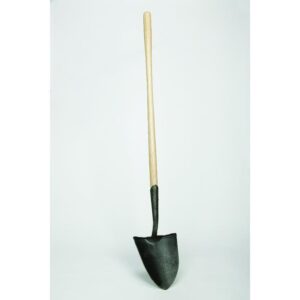Description
Although standard garden spades can be used, customized shovels with blades long enough to accommodate large containers are used by professional planters. Wooden handles are standard, but fiberglass handles are lighter. Blades are reinforced to endure the vigorous prying action used to open planting holes. Planting shovels or spades are particularly useful for planting large stock in deep, loose soils.
Application
Sites with vegetation require a two-person planting team with the scalper removing vegetation before the planter digs the hole. Shovels are used to create a hole by pushing the blade into the soil using the foot pads and removing the loosened soil until the proper hole size and depth are reached. Once the hole is ready, the nursery plant is placed in the hole and held in a vertical position while the planter backfills around the root plug. Soil amendments, fertilizers, and other in-soil treatments are easily applied with planting shovels. It is good idea to keep spare handles, footpads, and tools for installing parts and sharpening blades at the revegetation site.
References / Additional Information
Haase, D.L.; Landis, T.D.; Dumroese, R.K. 2014. Outplanting [Chapter 17]. In: Wilkinson, K.M.; Landis, T.D.; Haase, D.L.; Daley, B.F.; Dumroese, R. K., eds. Tropical nursery manual: A guide to starting and operating a nursery for native and traditional plants. Agriculture Handbook 732. Washington, DC: U.S. Department of Agriculture, Forest Service: 313-337.
Shaw, N.L.; Halford A; McAdoo, J.K. 2015. Establishing big sagebrush and other shrubs from planting stock. Great Basin Factsheet Series No. 8. Sage Grouse Initiative. 6 p.


